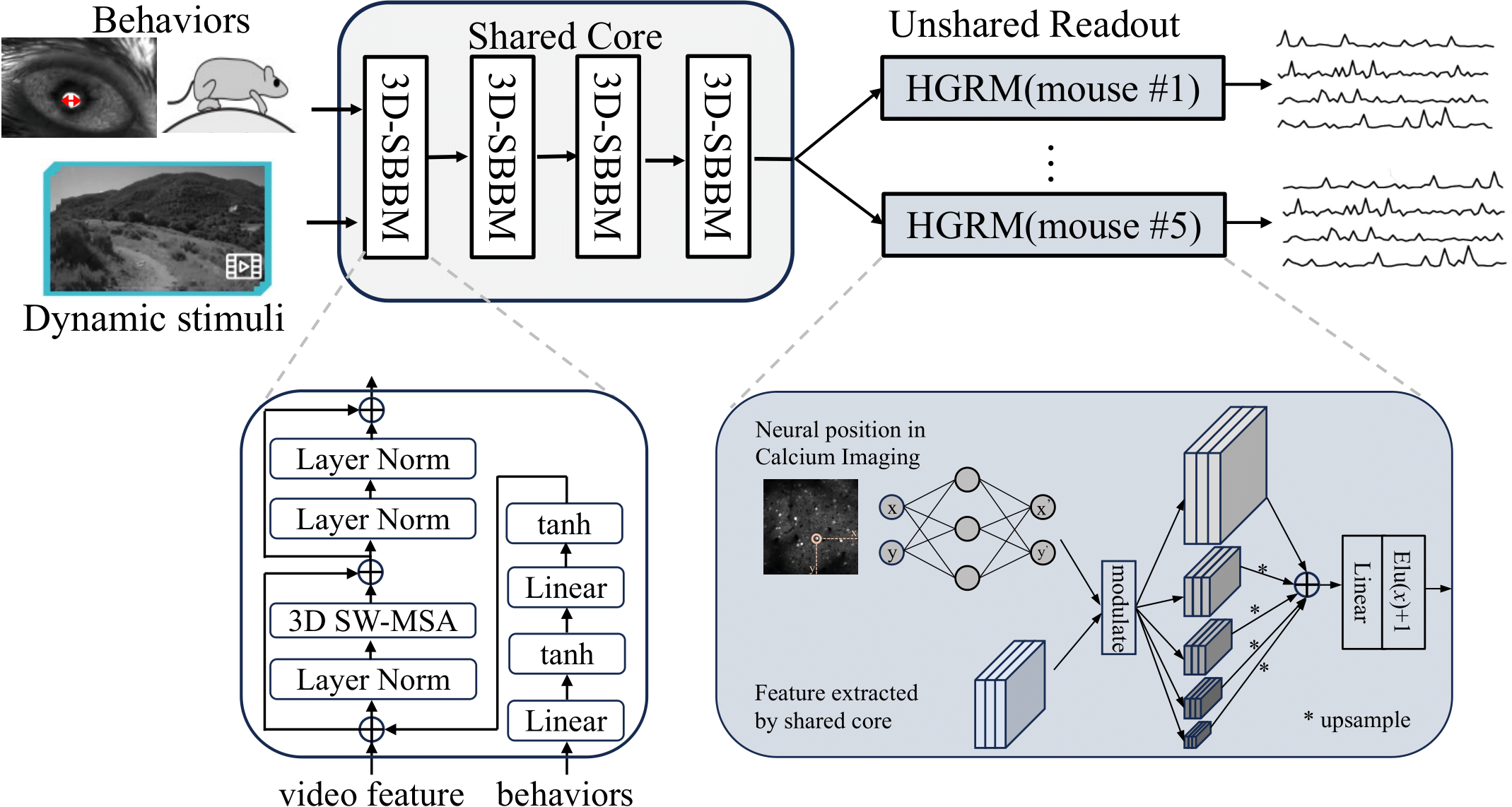Large-Scale Functional Modeling of Visual Cortex with Dynamic Stimuli [2nd solution in SENSORIUM 2023]
- Authors: Yu Zhu
Architecture. Our model, Dynamic-V1FM (Dynamic V1 Functional Model), follows the pipeline proposed by Eric et al. [1,2] It incorporates a shared core module across mice and an unshared readout module for individual mice. The shared core module comprises 4 basic 3D-SBBM modules, based on the 3D swin transformer block [3] combined with a two-layer behavioral MLP (multi-layer perceptron) module [4]. Our readout module, Hierarchical Gaussian Readout Module (HGRM), extends the Gaussian readout [5] module by introducing a multi-layer design before the final linear readout.
Ensemble Strategy. As the readout module could support up to 5 levels of features, we traversed four combinations of low-resolution features, i.e.,
conda env create -f environment.yml
Note: please restrictly follow this environment, otherwise the results can not be reproduced.
python train.py config/neuroencoding.py
Note: the training needs 8 2080Ti GPUs with the batch size 32, it would take about 1-1.5days for single model training. We load all the data to the memory for speeding up training, which requires at least 256GB memory.
Please go to the folder submission_func.
1. run each line in submission.ipynb
or
# test submitted results.
python Ensemble_func_mainTrack.py
python Ensemble_func_OODTrack.py
# test each model's results in the above submitted results.
python single_model_mainTrack.py
python single_model_OODTrack.py
We provide all the pretrained weight.
Note: the inference needs 8 2080Ti GPUs, it would take about 2-3 hours for single model.
[1] Eric Y Wang, Paul G Fahey, Kayla Ponder, Zhuokun Ding, Andersen Chang, Taliah Muhammad, Saumil Patel, Zhiwei Ding, Dat Tran, Jiakun Fu, et al. Towards a foundation model of the mouse visual cortex. bioRxiv, 2023.
[2] Polina Turishcheva, Paul G Fahey, Laura Hansel, Rachel Froebe, Kayla Ponder, Michaela Vystrˇcilová, Konstantin F Willeke, Mohammad Bashiri, Eric Wang, Zhiwei Ding, et al. The dynamic sensorium competition for predicting large-scale mouse visual cortex activity from videos. ArXiv, 2023.
[3] Ze Liu, Jia Ning, Yue Cao, Yixuan Wei, Zheng Zhang, Stephen Lin, and Han Hu. Video swin transformer. In Proceedings of the IEEE/CVF conference on computer vision and pattern recognition, pages 3202–3211, 2022.
[4] Bryan M Li, Isabel M Cornacchia, Nathalie L Rochefort, and Arno Onken. V1t: large-scale mouse v1 response prediction using a vision transformer. arXiv preprint arXiv:2302.03023, 2023.
[5] Konstantin-Klemens Lurz, Mohammad Bashiri, Konstantin Willeke, Akshay K Jagadish, Eric Wang, Edgar Y Walker, Santiago A Cadena, Taliah Muhammad, Erick Cobos, Andreas S Tolias, et al. Generalization in data-driven models of primary visual cortex. BioRxiv, pages 2020–10, 2020.
